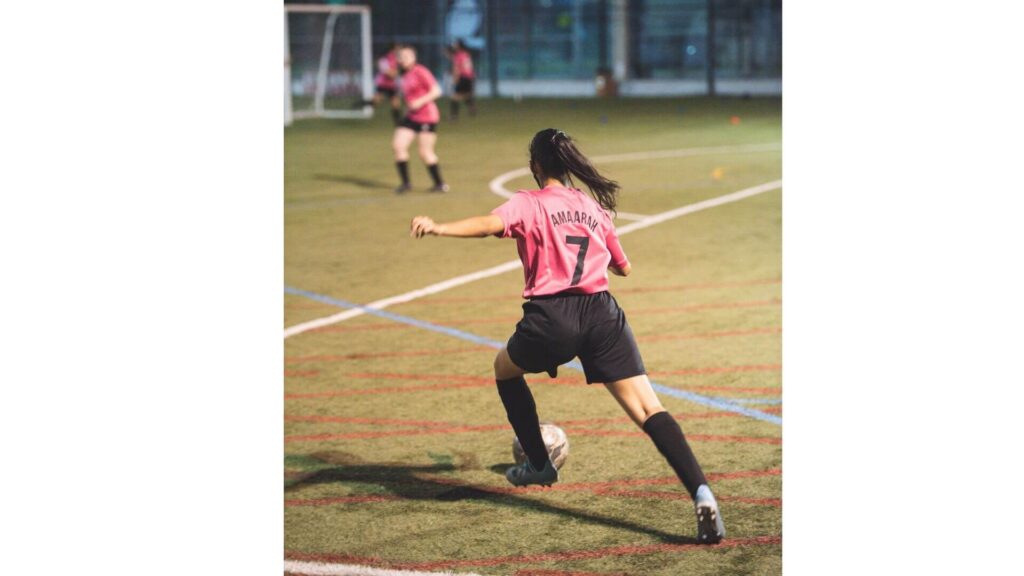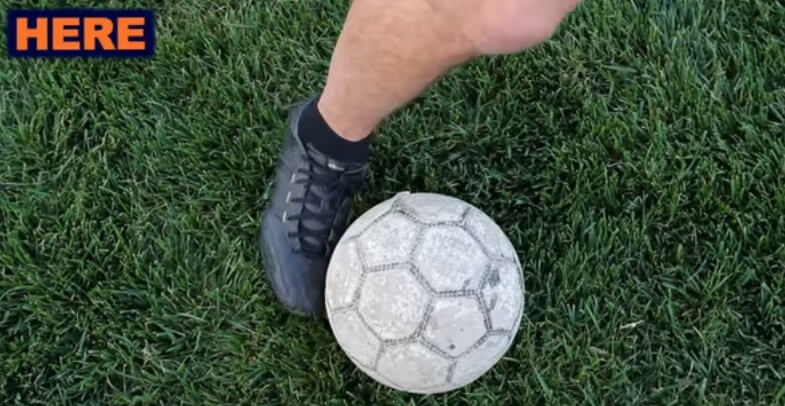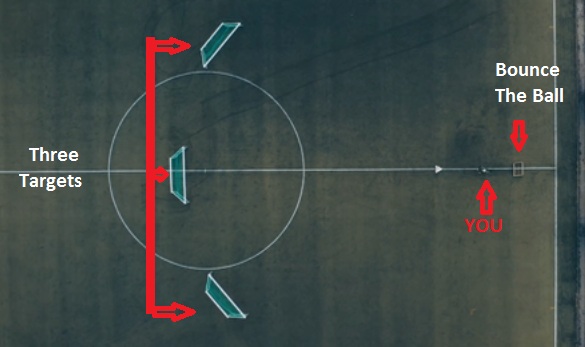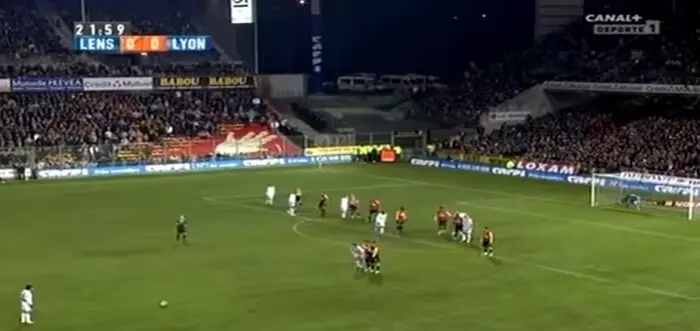Last Updated: Jun 26, 2023
Welcome to this guide about long passing in soccer.
The most common action for every soccer/football player on the pitch is receiving the ball, finding a new teammate and then passing the ball to them.
Most of the time, you might be in a situation where you have to kick a long ball to a teammate…
But, what is a long pass in soccer? How do you execute one?
In this article, you are going to learn everything there is to know about long passing in soccer.
Quick Navigation
- 1. What Is A Long Pass In Soccer/Football?
- 2. How To kick A Long Ball In Soccer?
- 3. Different Types of Long Passes
- 4. How Do You Get A Long Passing In Soccer?
- 5. Why Is Long Passing Important In Football?
- 6. When Not to Play a Long Pass
- 7. When Are Long Balls Needed In A Game?
- 8. How To Improve Long Passing In Football/Soccer?
- 9. How to Defend Against Long Passes?
- 10. Long Passing Techniques and Drills for Training:
- 11. Long Passing in Different Game Situations
- 12. Tactical Considerations for Long Passing
- 13. Combination of Play and Long Passing
- 14. Vision and Decision Making in Long Passing
- 15. Long Passing in Set Pieces
- 16. Long Passing as a Defensive Tactic
- 17. Psychological Impact of Long Passes
- 18. Long Passing in Different Playing Styles
- 19. Adapting to External Factors
- 20. Continuous Improvement and Practice
- 21. Long Passing in Different Positions
- Final Thoughts
1. What Is A Long Pass In Soccer/Football?
A long pass in soccer/football is a type of pass where the ball is kicked over a longer distance to reach a teammate who is further away on the field. This type of pass is often used to quickly transition the ball from one end of the field to the other, bypassing several opposing players in the process.
Long passes require a high degree of accuracy, power, and technique, as they must be delivered precisely to the intended target, while also accounting for factors such as wind and pitch conditions.

In addition to being a useful offensive strategy, long passes can also be an effective defensive tactic, allowing teams to clear the ball away from their own goal area and relieve pressure on their defense.
Now that you know the meaning of a long pass, let’s see how you can execute it in soccer.
==>> By the way, if you are still confused about why we use the words “Football” and “soccer”, you should read this article to learn why football is also called soccer.
2. How To kick A Long Ball In Soccer?
To kick a long ball in soccer, you need to learn and implement the tips given below:

- Line up behind the ball, not to the side.
- Your shoulders should face your target.
- Keep your plant foot two steps away from the ball when you make contact.
- Strike the lower part of the ball but not under the ball.
- Make sure your body is slightly bent when kicking the ball.
- Strike the ball right below the base of your big toe like in the pic above.
- Don’t try to bend the ball.
- Unlike the Ping, a long ball doesn’t take that much power as long as you have the proper technique.
- Watch goalkeepers like Buffon, Neur, etc. They are the perfect example of how to kick a long ball.
3. Different Types of Long Passes
There are several different types of long passes that players can execute, each with its own unique characteristics and purposes.
The most common type of long pass is the lofted pass, where the ball is hit with an arc to send it over defenders and land at the feet of a teammate further up the field.
Another type of long pass is the driven pass, which is hit with more power and speed along the ground to quickly move the ball up the field.
The chip pass is another option, which is a delicate and precise pass that lifts the ball just over the defender’s foot and into the path of a teammate.
Lastly, the diagonal long pass is a pass that is hit diagonally across the field to switch play and create space for attacking players.
Each type of long pass requires a different technique and skill set, but mastering them can be invaluable in a team’s strategy and success on the field.
4. How Do You Get A Long Passing In Soccer?
Receiving a long pass in soccer isn’t that easy. But with the right tips plus some practice, you are going to get better at it.
Here are some tips for getting a long pass in soccer:
- You have to be on your toes with a low centre of gravity. It will help you be ready to adjust to the flight of the ball.
- Create a cushion effect with the ball. Right before the ball is about to make contact with your foot, you have to slightly move your foot away to absorb the impact.
- You can use the inside, outside, the sole of the foot and your chest to control the ball.
- Master your first touch.
- Follow the trajectory of the ball. Don’t take your eyes away from the ball.
- Practice it with a wall. Hit the wall with the ball and try to control it in the air effectively.
- If you can’t find a wall, kick the ball in the air as high as you can and try to receive it.
Remember, practice makes perfect.
5. Why Is Long Passing Important In Football?
Long passing in football/soccer plays a crucial role in the game for several reasons. Here are a few key reasons why long passing is important in football:
1. Breaking Through Defenses:
Long passing allows teams to bypass compact and well-organized defenses. When opponents have a strong defensive structure, playing short passes may prove challenging. In such situations, long passes can be used to quickly advance the ball and create goal-scoring opportunities by catching the defense off-guard.
2. Switching Play:
Long passes are instrumental in switching the play from one side of the field to the other. By swiftly transferring the ball to the opposite flank, teams can exploit open spaces, change the direction of attack, and create new passing angles. This can disorient the opposition and create advantageous situations for the team in possession.
3. Creating Space:
Long passing can help create space on the field. By stretching the opposition’s defensive line with accurate long passes, players can open up gaps for teammates to exploit. This allows for more dynamic and varied attacking options, making it harder for defenders to predict and neutralize the team’s movements.
4. Initiating Counterattacks:
Long passes are instrumental in initiating counterattacks. When the opposing team loses possession, a well-executed long pass can quickly transition the ball from defense to attack. This rapid change of direction catches opponents out of position and creates opportunities for fast and direct attacking moves.
5. Relieving Defensive Pressure:
Long passes can be an effective defensive tactic. When a team is under pressure in their defensive zone, a well-placed long pass can clear the ball and relieve the defensive pressure. This provides an opportunity for the team to regroup, reorganize their shape, and regain control of the game.
6. Exploiting Height and Strength:
Long passes utilize the height and strength of players, especially in aerial duels. Forwards and attacking players who excel in winning headers can be targeted with accurate long passes. This strategy can be particularly effective in crowded midfield areas or when the team wants to bypass the opponent’s pressing.
Toni Kroos and Pirlo are the perfect examples of long balls.
6. When Not to Play a Long Pass
Playing a long pass can be a useful tool for moving the ball quickly up the field and creating scoring opportunities.
However, there are times when it’s not the best option.
For example, if the opposing team has a high-pressing defense, attempting a long pass can lead to turnovers and counterattacks.
In addition, if the player attempting the long pass is under pressure or doesn’t have a clear view of their teammates’ positioning, the pass may not be accurate or may go out of bounds.
It’s important for players to assess the situation and consider other options, such as passing the ball backwards or sideways, to maintain possession and build up the play.
7. When Are Long Balls Needed In A Game?
Here are the most common reasons to hit a long pass during a game:
1-In a counterattack
Let’s say there is team A vs team B.
If team A fails to score and the goalie or a defender from team B gets the ball, they can play as fast as possible to run a counter-attack. In this case, a long ball can be needed to find a striker or any forward player to create a goal-scoring opportunity.
2-To Switch Up The Play
When defenders are playing short passes to build up the play and find solutions, they might be under pressure from the opposing forwards. In this case, defenders can play a long ball to another teammate on the other side of the pitch to get out of the pressure.
This also applies to midfielders and wingers.
A winger can play a long ball to the other side of the pitch for another winger if he doesn’t find a solution on his side.
8. How To Improve Long Passing In Football/Soccer?
In soccer, improving long passing is all about practice and repetition.
But, of course, you have to know the perfect drills and tips to get better at it. Here’s what you should take into consideration to be great at passing long balls:

- Find three targets and something to bounce the ball from. Try different angles for receiving and distributing the ball like in the pic above.
- It has to be a very comfortable distance for you.
- Don’t kick the ball too hard.
- You have to get the perfect repetition every time.
- Don’t place your target too far away.
- Find the distance that best suits you.
- Practice 50-100 repetitions with both legs.
- Focus on making every repetition as game-like as possible.
- Look over your shoulder before receiving the bounced pass.
- Challenge yourself to try different angles and approaches to the ball.
- Direct the way you take the first touch.
This is, of course, if you are training by yourself.
9. How to Defend Against Long Passes?
Defending against long passes in soccer requires a combination of strategies and techniques.
First, defenders need to maintain good positioning and be aware of their surroundings, anticipating where the ball might be played.
They also need to communicate with their teammates and coordinate their movements to ensure that they cover all potential areas that the ball may be played into.
Additionally, defenders need to be prepared to contest for the ball in the air, using their height, jumping ability, and timing to win headers.
Finally, defenders need to be able to quickly transition from defending against a long pass to attacking or counter-attacking, in order to take advantage of any turnovers in possession.
10. Long Passing Techniques and Drills for Training:
To improve your long passing skills, it’s essential to practice specific techniques and drills. Here are some exercises you can try:
a) Target Practice: Set up three targets at different distances and angles on the field. Practice hitting each target with accurate and controlled long passes using both feet. This drill will help you develop precision and consistency in your passing.
b) Bounce Passes: Find a wall or a rebounder and practice receiving and distributing the ball with one touch using long passes. Focus on controlling the ball and quickly releasing it with accuracy. This drill will simulate game-like situations and improve your ability to handle the ball under pressure.
c) Game-Like Scenarios: Set up small-sided games where the emphasis is on playing long passes. Create situations that require you to identify open spaces and execute long passes to your teammates. This drill will improve your decision-making and vision for long passing in realistic game scenarios.
Remember, regular practice and repetition are key to improving your long passing technique.
11. Long Passing in Different Game Situations
Long passing strategies can vary depending on the game situation you find yourself in. Here are some examples:
a) Attacking from Deep Positions: When your team is trying to break through a compact defense, a well-executed long pass can bypass multiple defenders and create scoring opportunities. Look for spaces behind the defensive line to send accurate long passes that catch opponents off guard.
b) Initiating Counterattacks: If your team wins possession deep in your own half, a quick and accurate long pass can launch a counterattack. Identify teammates making forward runs and deliver a well-weighted pass to spring them into space.
c) Playing Under Pressure: When opponents are pressing high and closing down passing lanes, a long pass can relieve pressure and switch the play to the opposite side of the field. Look for teammates in open spaces and execute diagonal or cross-field long passes to change the direction of the attack.
Adapting your long passing strategy to different game situations can be crucial for your team’s success.
12. Tactical Considerations for Long Passing
Long passing is not just about kicking the ball over a long distance. It requires tactical understanding and coordination with your teammates. Here are some tactical considerations:
a) Exploiting Weaknesses: Analyze the opponent’s defensive structure and identify areas where they are vulnerable to long passes. Look for gaps in their defensive line or isolated defenders that you can target with accurate long balls.
b) Creating Space: Long passing can be used strategically to create space for your teammates. By playing a long pass to one side of the field, you can attract defenders and open up space on the opposite side for your teammates to exploit.
c) Communication: Effective long passing often relies on good communication between the passer and the intended receiver. Use verbal and non-verbal cues to communicate your intentions and coordinate movements with your teammates.
By incorporating these tactical considerations, you can maximize the effectiveness of your long passing game.
13. Combination of Play and Long Passing
Long passing can be combined with other elements of play to create effective attacking moves. Here’s how you can utilize combination play with long passes:
a) Movement Off the Ball: Coordinate your long passes with the movement of your teammates. Look for players making runs into space and deliver a well-timed long pass to their path.
b) Positional Interchange: Long passes can be used to facilitate positional interchange among players. For example, a winger can play a long pass to a teammate in a central position, allowing the winger to move into a more advanced position.
c) Passing Triangles: Create passing triangles with your teammates to maintain possession and progress up the field. Use long passes to connect with a teammate who can quickly lay the ball off to another player, thus bypassing opponents and maintaining fluid attacking play.
By incorporating combination play with long passes, you can create dynamic and unpredictable attacking moves.
14. Vision and Decision Making in Long Passing
Executing accurate long passes requires good vision and decision making. Here are some factors to consider:
a) Reading the Game: Develop your ability to read the game and anticipate opportunities for long passes. Look for spaces and movement of your teammates and opponents to make informed decisions.
b) Identifying Open Spaces: Identify open spaces where your teammates can receive the long pass without immediate pressure from opponents. These spaces can be behind the defensive line, in wide areas, or between midfield and defensive lines.
c) Choosing the Right Passing Option: Assess different passing options before executing a long pass. Consider the skill, positioning, and movement of your teammates to select the most effective passing option. Avoid forcing long passes into congested areas.
15. Long Passing in Set Pieces
Long passing can play a significant role in set-piece situations. Here’s how you can utilize long passes in football:
a) Free Kicks: In free-kick situations, long passes can be employed to bypass defensive walls and find a teammate in a scoring position. Coordinate with your teammates to execute well-timed and accurate long passes that catch the opposition off guard.

b) Corner Kicks: Long passes from corner kick situations can surprise defenders and create scoring opportunities. Look for teammates making runs towards the edge of the box or far post and deliver lofted or driven long passes to them.
c) Goal Kicks: Instead of playing short goal kicks, long passes can be used to quickly transition from defense to attack. Target a teammate further up the field who can control the long pass and initiate an attacking move.
By incorporating long passes into set-piece situations, you can add a dimension of surprise and create scoring chances.
16. Long Passing as a Defensive Tactic
Long passing is not limited to offensive strategies; it can also be an effective defensive tactic. Here’s how you can utilize it:
a) Clearing the Ball: When under pressure in your defensive zone, a well-executed long pass can help clear the ball from dangerous areas. Look for a teammate further up the field and deliver a powerful and accurate long pass to relieve pressure on your defense.
b) Counterpressing: Long passes can be used as a counter-pressing technique. If your team loses possession, quickly regaining it by intercepting an opponent’s pass and immediately playing a long pass to a teammate can catch the opposing team off guard and disrupt their attacking rhythm.
c) Disrupting Opposition’s Shape: Well-placed long passes can disrupt the opposition’s defensive shape and force them to readjust quickly. By bypassing their midfield and defensive lines, you can create opportunities for your team to exploit gaps and launch counterattacks.
By incorporating long passing as a defensive tactic, you can regain control, disrupt the opponent’s rhythm, and relieve pressure on your defense.
17. Psychological Impact of Long Passes
Long passes not only have a physical impact on the game but also a psychological one. Here’s how long passes can affect the game mentally:
a) Creating Uncertainty: Accurate and well-executed long passes can create uncertainty and disrupt the opponent’s defensive organization. The threat of a long pass can force defenders to drop deeper or mark players more tightly, creating opportunities for your team to exploit spaces.
b) Boosting Confidence: Successfully executing a long pass can boost confidence for both the passer and the receiver. It can energize the team and instil a sense of belief in their ability to overcome the opposition’s defense.
c) Demoralizing Opponents: Consistently executing effective long passes can demoralize opponents, especially when they repeatedly fail to intercept or defend against them. It can undermine their defensive strategy and make them doubt their abilities to control the game.
Understanding the psychological impact of long passes can help you leverage them as a strategic advantage in matches.
18. Long Passing in Different Playing Styles
Long passing can be incorporated into various playing styles. Here are a few examples:
a) Direct Style of Play: Teams that adopt a direct style of play rely heavily on long passes to quickly transition from defense to attack. Long passes are used to bypass midfield lines and launch quick counterattacks or find target players up front.
b) Possession-Based Style: Even in possession-based playing styles, long passes can be used strategically. They are employed to switch the play, stretch the opposition’s defense, and create space for attacking players to exploit.
c) Counterattacking Style: Long passes are instrumental in counterattacking styles of play. They help in launching fast and incisive attacks, catching opponents off guard and exploiting spaces behind their defensive lines.
19. Adapting to External Factors
Long passing can be affected by external factors that are beyond your control. Here’s how to adapt:
a) Wind Conditions: Strong winds can affect the trajectory and accuracy of long passes. Adjust your passing technique and power accordingly to compensate for the wind’s influence. Consider the wind’s direction and intensity to make more informed decisions.
b) Pitch Conditions: The condition of the pitch, such as its hardness or wetness, can affect the accuracy and control of long passes. Adapt your technique to account for any variations in ball bounce and surface friction.
c) Player Fitness: Fatigue can impact the execution of long passes. As the game progresses, monitor your energy levels and adjust your passing technique and power accordingly to maintain accuracy.
20. Continuous Improvement and Practice
Improving long passing skills requires consistent practice and dedication. Here are some tips to enhance your long passing ability:
a) Technical Training: Focus on improving your passing technique, including body positioning, striking the ball cleanly, and generating power and accuracy. Work on both lofted and driven long passes to develop versatility.
b) Vision and Awareness: Develop your vision and awareness of the game by studying and analyzing matches. This will help you identify passing opportunities and make effective long-pass decisions.
c) Game-Like Scenarios: Practice long passing in game-like scenarios to simulate real match situations. Incorporate movement, pressure, and decision-making into your training drills to replicate the challenges faced during games.
d) Feedback and Analysis: Seek feedback from coaches or teammates to identify areas for improvement. Analyze your performance in matches and training sessions to identify strengths and weaknesses in your long passing ability.
21. Long Passing in Different Positions
Long passing skills are valuable for players in various positions on the soccer field. Here’s how different positions can utilize long passing:
a) Goalkeepers: Goalkeepers play a vital role in distributing the ball and initiating attacks. Their ability to execute accurate long passes allows them to quickly transition from defense to attack. Long goal kicks or precise throws to teammates further up the field can bypass opponents and launch counterattacks.
b) Defenders: Defenders often play a significant role in initiating attacks from the back. Long passes from defenders can help break through the opposition’s midfield lines and find teammates in advanced positions. Additionally, long passes can be used as a defensive strategy to clear the ball from the defensive zone and relieve pressure on the backline.
c) Midfielders: Midfielders are crucial in dictating the flow of the game and distributing the ball effectively. Long passes from midfielders can switch the play, stretch the opposition’s defense, and create goal-scoring opportunities. They also play a pivotal role in initiating counterattacks by delivering accurate long passes to attacking players.
d) Forwards: Forwards benefit from long passes by creating goal-scoring opportunities. They can use their positioning and movement to receive long passes and either score directly or set up teammates. Long passes can be particularly useful when forwards make runs behind the opposition’s defensive line or when they need to hold up the ball and involve teammates in the attack.
Understanding how long passing applies to different positions allows players to make effective decisions and contribute to their team’s overall strategy.
Final Thoughts
Long passing is one of the most powerful techniques in soccer/football.
It can be difficult to master but with practice and determination, you’ll achieve great results.
At last, whether you are a striker, a goalie, a midfield or a defender, you necessarily need to master the long balls.
Do you have any questions about long passing? Any tip you would like to add? Let us know in the comment section below.


I love this thanks I really appreciate
No problem, Emmanuel.
Thanks for the tips
My pleasure